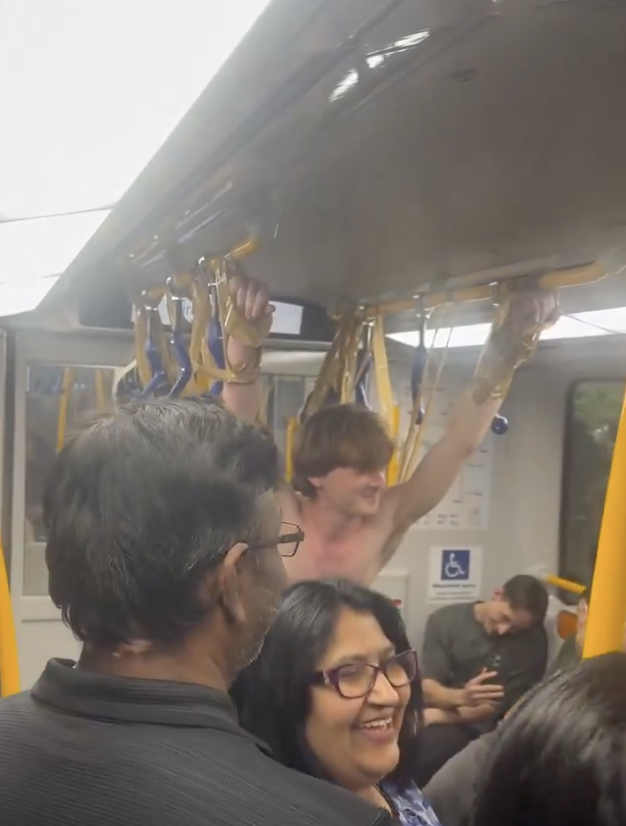
Disclaimer: This article contains descriptions of dangerous acts that may be distressing to some readers. Reader discretion is advised, as certain details may evoke discomfort or concern. If you find such topics upsetting, please proceed with care.
A 19-year-old’s bid for social media fame has landed him in serious legal trouble after performing a bizarre and dangerous stunt on a packed Sydney train that left fellow passengers stunned and authorities expressing concern about potential copycats.
The teenager, who goes by ‘Joshua Cherub’ on social media, was charged on Friday after allegedly suspending himself from the roof of a train carriage using zip ties and cellophane tape while shirtless, as his friends filmed the 28 September spectacle for online content.
What might seem like a harmless prank to some represents a growing and genuinely dangerous trend that’s seeing young Australians risk their lives for social media notoriety—with potentially devastating consequences.
Transport Minister John Graham told Daily Mail that while the stunt ‘may look like harmless fun,’ acts like this ‘are dangerous on a moving vehicle or a platform.’
The shocking stunt that stopped commuters in their tracks
Joshua Cherub was found with his feet and hands taped, hanging from the overhead railings of a Sydney Trains carriage, creating what he later called ‘Performance art number six’ in a social media post that tagged NSW Police directly.
The incident unfolded after police had already encountered Cherub earlier that day. Officers saw the teen seated on a chair bound with tape and issued a move-on direction at Town Hall Station, which he allegedly ignored before performing the more dangerous roof suspension stunt.
Police said they began to disperse the group due to safety concerns.
Passengers were left stunned and confused by the spectacle, while the teenager’s friends filmed the episode to upload it to social media, linking to a page where he is selling merchandise.
The brazen nature of the stunt—and the fact that Cherub is monetising his dangerous behaviour through merchandise sales—highlights how social media culture can encourage increasingly risky acts among young people chasing online fame.
Legal consequences and police warnings
NSW Police have made it clear they’re taking these incidents seriously. Cherub faces one charge of refusing to comply with police directions, and officers have warned potential copycats to stop their ‘anti-social behaviour’ on public transport.
‘It is not only illegal but is also extremely dangerous and reckless,’ police said in a statement. ‘Anyone else who participates in such an action will be subject to immediate prosecution.’
Transport Minister John Graham also pointed out that the Rail Operations Centre monitors the network with CCTV around the clock, meaning these stunts are likely to be caught on camera.
The teenager is scheduled to face court in November, where he’ll learn the full legal consequences of his actions.
Source: Instagram / austoday and its_called_straya
The social media factor driving dangerous behaviour
What’s particularly troubling about this incident is how social media appears to be driving increasingly dangerous acts. Despite facing legal trouble, Cherub’s video drew a large amount of engagement, with comments like ‘What a creative art installation’ and ‘This is so beautiful and meaningful.’
This kind of feedback, along with the attention gained from social media and merchandise sales, may encourage some young people to take unnecessary risks online.
The phenomenon isn’t limited to this single act. Cherub has performed several other stunts, including taping himself to a post covered in paint and strapping himself to a chair near light rail tracks—all posted online.
Why this matters for public safety
- Encourages copycat behaviour among impressionable young people
- Puts innocent commuters at risk and causes service disruptions
- Diverts emergency resources from genuine emergencies
- Normalises dangerous behaviour as entertainment
- Can result in serious injury or death for participants
The broader implications for families and communities
For many Australians—particularly parents and grandparents—this incident raises real concerns about how social media culture is shaping young people’s decision-making. The pursuit of online fame appears to be overriding basic safety instincts and respect for the law.
The fact that Cherub tagged police in his video and later promoted merchandise related to the stunt highlights a possible disconnect between actions and consequences—something that may be difficult for many older Australians to understand.
These stunts also affect the broader community through service disruptions, increased security costs, and the emotional distress experienced by other passengers and train staff who witness them.
Did you know?
Did you know?
Train surfing and other dangerous stunts on public transport have been documented globally, but social media has amplified their reach—making such behaviour more visible and, unfortunately, more appealing to risk-takers.

The Joshua Cherub case serves as a stark reminder that what some young people call ‘performance art’ can have very real legal, safety, and community consequences.
While the teenager awaits his court appearance, authorities continue working to prevent similar incidents and protect both perpetrators and bystanders from the potentially devastating outcomes of these reckless acts.
What are your thoughts on how social media might be influencing risky behaviour among young people? Have you noticed changes in public behaviour on public transport? Let us know in the comments below!







